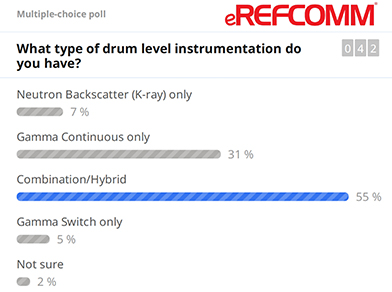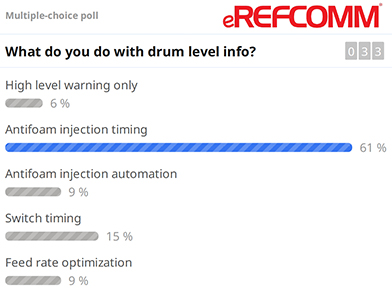![]() Facilitator: Evan Hyde – REFCOMM®
Facilitator: Evan Hyde – REFCOMM®
Overview

For many years, the only indication for the coke drum level was the Neutron-Backscatter (NBS) type. Then in the 90’s, continuous level gamma source instruments were developed. Their rollout has been gradual for the existing installed capacity and they are the standard on new grassroots units. However, even today, there are many units still operating with only NBS or a combination of NBS and Gamma level instruments.
It came as a shock for many operators that the only vendor of NBS equipment in the world has chosen to exit the market effective immediately. As a result, our industry needs to have a transition plan to phase out the old instruments, install new instruments where needed, and finally, make sure everyone understands how to use the gamma level instruments properly. The goal of this session will be to explore the differences between the two measurements and to discuss our industry plans for the transition to a future with only gamma level instruments.
Sponsors:
Webinar Recap

In the beginning, levels in Dubbs stills and some delayed cokers were measured by nozzles and valves along the side of the coke drum. It sounds as crazy as it was. The industry improved its methods, and neutron backscatter (NBS) was the only and best option for 30 plus years. The point source level measurement proved to be a safe and reliable way to understand where coke, foam, and water were in the coke drum. Unfortunately, the only remaining vendor of these instruments, ThermoFisher, has elected to stop service on this market effective 31 January 2020. This came as a surprise to many of us in the industry. As a result, we are trying to move forward in the absence of NBS in the very near future. Gamma level instruments are the current standard on all new construction and are principally provided by our two sponsors for this event, VEGA and Berthold.
The poll results indicated that more than half of the respondents during this event had a combination of gamma and NBS systems. Interestingly, our poll also showed that 7% only have NBS; whereas our knowledge of the industry generally says that ~50% of drums in the world have NBS only and 20% have the combination. Regardless, there are still many sites with NBS systems where obsolescence is coming.

Understanding the difference in the measurement from NBS and gamma is critical to knowing what the instrument is telling you during operation. Unlike a simple, clean fluid liquid level, which is a direct measurement, putting a nuclear source of energy into the coke drum and detecting what is there can be tricky. There is a lot to unpack but here is the short version. NBS measures the backscatter (reflection) of energy directly in the vicinity of the device, around 18″ (45cm) in any direction and is sensing the presence of hydrogen only. Gamma is sensing the remaining radiation across the full cross-section of the drum in a continuous detector about 20ft (6m) long. The gamma radiation is absorbed by anything in the path of that beam and the detector interprets the level based on a lower radiation count at the detector. Both of these instruments have functionality and merit and if interpreted correctly can give you a very clear picture of what is occurring in the drum.
Various installations for both NBS and Gamma systems were reviewed. Best practices for keeping the systems functional can lead to equipment which lasts turnaround to turnaround; however, poor installations can see detectors with less than 6 months’ life. Care should be taken to manage water and heat around the instruments as these two factors can be the primary cause for damage and malfunction. If your coke drum suffers from severe banana deformation, you should keep an eye on the instruments for damage as well.
The poll results demonstrated that the most common reason for knowing drum level is to know when and how effective antifoam injection is. However, it is notable to see how some clever sites are using this information for feed rate optimization and antifoam automation. These could be real money makers…..But it is important to understand what the data is telling. Some examples where NBS and gamma trends were reviewed show interesting case studies where things are moving together but also where the instruments are moving in the opposite direction simultaneously while both instruments are functioning properly.

The vapor density instrument or top point switch is an often overlooked but critical device which can be used in a variety of clever ways. Such as,
- Gas Property Compensation
- High Level to shut off water
- Monitor for Particulate Matter Carryover
- Monitor Coke build up for dome clean outs
Moving away from NBS in the future will present challenges for many older units, because accessibility to the ideal gamma source and detector locations can be as much as 5 times the cost of the instrument itself. To reduce these costs, vendors and engineering companies have been getting creative with platforms and placement. In addition, some sites have been employing gamma-based switches, which perform a similar function as the NBS with a very limited span but with high accuracy.
How the remaining 50% of coke drums with only NBS and 20% with combination systems will transition into the future is not clear. But it is clear that Thermo will no longer be supporting our industry. Through proper installation, calibration, operation, and interpretation of this critical instrument, we need to understand how to embrace gamma instruments and understand what they are telling us to ensure that there are no safety or reliability incidents.








